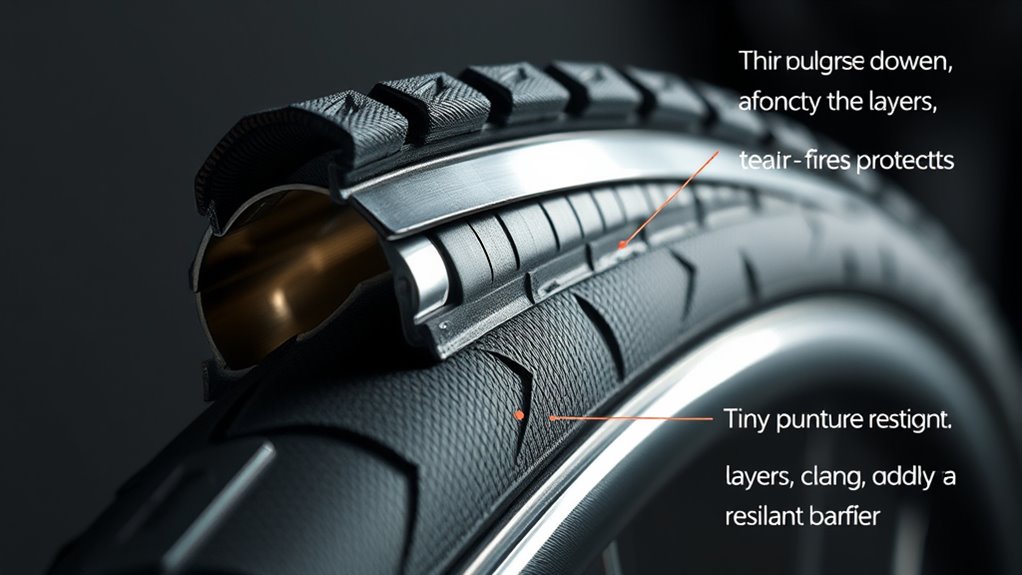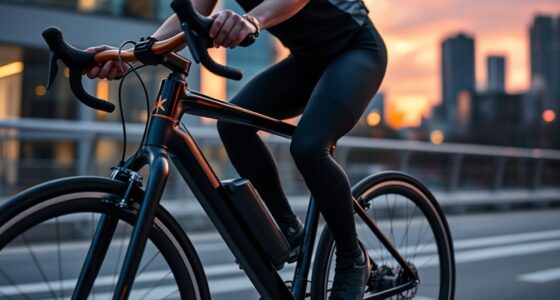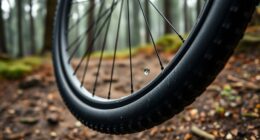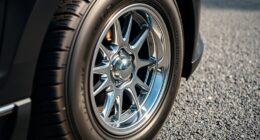TPI, casing materials, and puncture protection all affect your bike tire’s performance and durability. Higher TPI means a more supple, lighter tire with better grip, while lower TPI offers greater durability and resistance to punctures. The casing material, like nylon or cotton, influences ride comfort and wear, and reinforcements like Kevlar add extra protection. Understanding these factors helps you choose the right tire for your riding style—keep exploring to learn how to make the best choice.
Key Takeaways
- Higher TPI indicates a more supple, lightweight casing that enhances grip and ride comfort but may be less durable.
- Casing materials like nylon and cotton affect flexibility, durability, and ride feel, with cotton being softer and nylon more durable.
- Reinforcements such as Kevlar improve puncture resistance, especially useful for rough or trail riding environments.
- Lower TPI casings prioritize durability and puncture resistance but can result in a harsher ride.
- Choosing the right combination depends on riding terrain, puncture risk, and the balance between weight, comfort, and protection.

Understanding TPI, casing, and puncture protection is essential when choosing the right tire for your riding needs. These factors directly influence how a tire performs, how durable it is, and how comfortable your ride will feel. One of the key aspects to consider is the TPI rating, which stands for threads per inch. TPI ratings tell you how tightly woven the casing is, affecting flexibility, weight, and ride quality. Higher TPI ratings, like 120 or 180, use more threads per inch, resulting in a lighter, more supple tire that offers better grip and a smoother ride. Lower TPI ratings, such as 60 or 80, create a stiffer, more durable casing that’s less prone to punctures but can feel harsher on rough terrain. Choosing the right TPI depends on your riding style; if you prioritize speed and agility, a higher TPI casing might be your best bet, while durability and puncture resistance lean towards lower TPI options.
Casing materials also play an important role in tire performance. Most tires use either nylon or cotton-based casings, sometimes reinforced with additional materials like Kevlar or polyester. Nylon casings are common because they balance durability and weight, providing good puncture resistance without sacrificing too much flexibility. Cotton, on the other hand, offers a softer, more supple ride but tends to wear out faster and might need more frequent replacement. Reinforcements like Kevlar are added to create a puncture-resistant layer that protects against sharp objects, especially useful for mountain biking or rough trail riding. The choice of casing material impacts not only puncture protection but also the overall weight and ride feel. When selecting tires, consider where you’ll ride most often and how much puncture resistance you need versus weight savings. Additionally, modern tire technology often incorporates high TPI casings to enhance ride quality and reduce weight further.
Frequently Asked Questions
How Does TPI Affect Tire Flexibility and Ride Quality?
Higher TPI means your tire has more threads per inch, making it more flexible. This increased flexibility allows the tire sidewall and tread to move more easily, giving you a smoother ride. You’ll notice better compliance over bumps and a more comfortable feel, especially on rough terrain. Lower TPI tires tend to be stiffer, reducing ride quality. So, a higher TPI improves flexibility and enhances your overall riding experience.
What Are the Best Casing Materials for Extreme Terrains?
For extreme terrains, you should choose casings made from durable materials like reinforced nylon or Kevlar, which offer excellent sidewall reinforcement and tubeless compatibility. These materials withstand harsh impacts and abrasions, giving you better puncture resistance and confidence on rough trails. Look for tire casings specifically designed for aggressive riding, as they provide the durability needed without sacrificing flexibility or ride quality.
How Does Puncture Protection Impact Tire Weight and Performance?
Puncture protection can add weight to your tire, which might slightly reduce your speed and agility. However, it enhances puncture resistance, allowing you to maintain consistent tire pressure and avoid flats on rough terrains. While heavier tires may feel less nimble, the improved durability means fewer interruptions and better confidence. Balancing puncture resistance with weight helps you optimize performance, especially when tackling challenging trails where flats are more likely.
Can Casing Types Influence Tire Lifespan Significantly?
Yes, casing types can greatly influence your tire’s lifespan. When you opt for casing customization, you choose materials and structures that better resist wear and damage, extending durability. Casing manufacturing quality also plays an essential role, ensuring consistent strength and resilience. By selecting the right casing type, you can enjoy longer-lasting tires, reduced replacements, and better performance over time, making your riding experience more reliable and cost-effective.
Are There Trade-Offs Between TPI and Durability?
Yes, there are trade-offs between TPI and durability. Higher TPI tires typically offer a smoother ride and better flexibility, but they may have thinner sidewalls, reducing sidewall strength and making them more prone to damage. Lower TPI tires often have thicker casings, providing enhanced durability and easier casing repair, but they can feel stiffer. You’ll need to balance ride comfort with the need for stronger sidewalls and easier repairs based on your riding style.
Conclusion
Think of your tire as a shield, with TPI, casing, and puncture protection acting as the armor that guards your ride. When you choose the right combination, you’re not just selecting a tire—you’re forging a path through the unknown, confident and prepared. Remember, each layer symbolizes resilience and adventure. With the right protection, you’re not just riding — you’re embracing the journey, ready to conquer whatever lies ahead with unwavering trust in your gear.









